Seasonal Variations and Correlations of Optical and Physical Properties of Upper Cloud-Aerosol Layers in Russia Based on Lidar Remote Sensing
Abstract
1. Introduction
2. Research Methods
2.1. Study Area Overview
2.2. Data and Methods
3. Results and Discussion
3.1. Seasonal Variation in Optical and Physical Properties of High-Level Clouds in Russian Regions
3.2. Seasonal Variation in Optical and Physical Properties of Upper Aerosol Layers in Russian Regions
3.3. Upper Cloud-Aerosol Layer Correlation Analysis
3.3.1. Cloud-Aerosol Parameter Correlation Models
3.3.2. Representative Parameter Relationship Analysis
4. Conclusions
- (1)
- Seasonal cloud patterns: Summer convection produces thick clouds (TCOD: 1–2, TTc: 1–2 km, THc: 8–15 km), while winter shows thin/absent layers (TCOD < 1) with regular ice crystals. Nighttime cooling enhances cloud stability.
- (2)
- Complex aerosol structures: Despite low optical depth (TAOD < 0.05), multi-layered aerosols extend to 16–18 km from dust transport and biomass burning, with simpler nighttime distributions.
- (3)
- Cloud-aerosol coupling: Height correlations are moderate (nighttime R = 0.527–0.587), while optical relationships show weak linear but strong nonlinear correlations (MSE < 0.02).
- (4)
- Nonlinear dominance: Cubic and power models outperform linear fits, revealing threshold and saturation effects that require sophisticated parameterizations in climate models. Nighttime conditions optimize aerosol-cloud interaction quantification.
Author Contributions
Funding
Data Availability Statement
Acknowledgments
Conflicts of Interest
References
- Dagan, G.; Yeheskel, N.; Williams, A.I. Radiative forcing from aerosol–cloud interactions enhanced by large-scale circulation adjustments. Nat. Geosci. 2023, 16, 1092–1098. [Google Scholar] [CrossRef]
- Fan, J.; Rosenfeld, D.; Zhang, Y.; Giangrande, S.E.; Li, Z.; Machado, L.A.; Martin, S.T.; Yang, Y.; Wang, J.; Artaxo, P. Substantial convection and precipitation enhancements by ultrafine aerosol particles. Science 2018, 359, 411–418. [Google Scholar] [CrossRef]
- Li, Z.; Niu, F.; Fan, J.; Liu, Y.; Rosenfeld, D.; Ding, Y. Long-term impacts of aerosols on the vertical development of clouds and precipitation. Nat. Geosci. 2011, 4, 888–894. [Google Scholar] [CrossRef]
- Rosenfeld, D.; Sherwood, S.; Wood, R.; Donner, L. Climate effects of aerosol-cloud interactions. Science 2014, 343, 379–380. [Google Scholar] [CrossRef]
- Virtanen, A.; Joutsensaari, J.; Kokkola, H.; Partridge, D.G.; Blichner, S.; Seland, Ø.; Holopainen, E.; Tovazzi, E.; Lipponen, A.; Mikkonen, S. High sensitivity of cloud formation to aerosol changes. Nat. Geosci. 2025, 18, 289–295. [Google Scholar] [CrossRef]
- Erlanger, E.; Bufe, A.; Paris, G.; D’Angeli, I.; Pisani, L.; Kemeny, P.C.; Stammeier, J.; Haghipour, N.; Hovius, N. Deep CO2 release and the carbon budget of the central Apennines modulated by geodynamics. Nat. Geosci. 2024, 17, 465–471. [Google Scholar] [CrossRef] [PubMed]
- Roeckner, E.; Schlese, U.; Biercamp, J.; Loewe, P. Cloud optical depth feedbacks and climate modelling. Nature 1987, 329, 138–140. [Google Scholar] [CrossRef]
- Rosenfeld, D.; Zhu, Y.; Wang, M.; Zheng, Y.; Goren, T.; Yu, S. Aerosol-driven droplet concentrations dominate coverage and water of oceanic low-level clouds. Science 2019, 363, eaav0566. [Google Scholar] [CrossRef] [PubMed]
- Wang, N.; Zhang, K.; Shen, X.; Wang, Y.; Li, J.; Li, C.; Mao, J.; Malinka, A.; Zhao, C.; Russell, L.M. Dual-field-of-view high-spectral-resolution lidar: Simultaneous profiling of aerosol and water cloud to study aerosol–cloud interaction. Proc. Natl. Acad. Sci. USA 2022, 119, e2110756119. [Google Scholar] [CrossRef]
- Su, T.; Li, Z.; Henao, N.R.; Luan, Q.; Yu, F. Constraining effects of aerosol-cloud interaction by accounting for coupling between cloud and land surface. Sci. Adv. 2024, 10, eadl5044. [Google Scholar] [CrossRef]
- Morrison, H.; De Boer, G.; Feingold, G.; Harrington, J.; Shupe, M.D.; Sulia, K. Resilience of persistent Arctic mixed-phase clouds. Nat. Geosci. 2012, 5, 11–17. [Google Scholar] [CrossRef]
- Uno, I.; Eguchi, K.; Yumimoto, K.; Takemura, T.; Shimizu, A.; Uematsu, M.; Liu, Z.; Wang, Z.; Hara, Y.; Sugimoto, N. Asian dust transported one full circuit around the globe. Nat. Geosci. 2009, 2, 557–560. [Google Scholar] [CrossRef]
- O’Dowd, C.D.; Facchini, M.C.; Cavalli, F.; Ceburnis, D.; Mircea, M.; Decesari, S.; Fuzzi, S.; Yoon, Y.J.; Putaud, J.-P. Biogenically driven organic contribution to marine aerosol. Nature 2004, 431, 676–680. [Google Scholar] [CrossRef]
- Han, G.; Huang, Y.; Shi, T.; Zhang, H.; Li, S.; Zhang, H.; Chen, W.; Liu, J.; Gong, W. Quantifying CO2 emissions of power plants with Aerosols and Carbon Dioxide Lidar onboard DQ-1. Remote Sens. Environ. 2024, 313, 114368. [Google Scholar] [CrossRef]
- Han, G.; Zhang, H.; Huang, Y.; Chen, W.; Mao, H.; Zhang, X.; Ma, X.; Li, S.; Zhang, H.; Liu, J. First global XCO2 observations fromspaceborne lidar: Methodology and initial result. Remote Sens. Environ. 2025, 330, 114954. [Google Scholar] [CrossRef]
- Lefebvre, A.; Hélière, A.; Wallace, K.; Nakatsuka, H.; Tomita, E. The ESA EarthCARE mission development status. In Proceedings of the 2017 IEEE International Geoscience and Remote Sensing Symposium (IGARSS), Fort Worth, TX, USA, 23–28 July 2017; pp. 4234–4237. [Google Scholar]
- Sawamura, P.; Moore, R.H.; Burton, S.P.; Chemyakin, E.; Müller, D.; Kolgotin, A.; Ferrare, R.A.; Hostetler, C.A.; Ziemba, L.D.; Beyersdorf, A.J. HSRL-2 aerosol optical measurements and microphysical retrievals vs. airborne in situ measurements during DISCOVER-AQ 2013: An intercomparison study. Atmos. Chem. Phys. 2017, 17, 7229–7243. [Google Scholar] [CrossRef]
- Fang, J.; Huang, K.; Du, M.; Zhang, Z.; Cao, R.; Yi, F. Investigation on cloud vertical structures based on Ka-band cloud radar observations at Wuhan in Central China. Atmos. Res. 2023, 281, 106492. [Google Scholar] [CrossRef]
- Jimenez, C.; Ansmann, A.; Engelmann, R.; Donovan, D.; Malinka, A.; Seifert, P.; Wiesen, R.; Radenz, M.; Yin, Z.; Bühl, J. The dual-field-of-view polarization lidar technique: A new concept in monitoring aerosol effects in liquid-water clouds—Case studies. Atmos. Chem. Phys. 2020, 20, 15265–15284. [Google Scholar] [CrossRef]
- Yang, Y.; Zhao, C.; Wang, Q.; Cong, Z.; Yang, X.; Fan, H. Aerosol characteristics at the three poles of the Earth as characterized by Cloud–Aerosol Lidar and Infrared Pathfinder Satellite Observations. Atmos. Chem. Phys. 2021, 21, 4849–4868. [Google Scholar] [CrossRef]
- Bulygina, O.; Razuvaev, V.; Korshunova, N.; Groisman, P.Y. Climate variations and changes in extreme climate events in Russia. Environ. Res. Lett. 2007, 2, 045020. [Google Scholar] [CrossRef]
- Hugelius, G.; Bockheim, J.G.; Camill, P.; Elberling, B.; Grosse, G.; Harden, J.W.; Johnson, K.; Jorgenson, T.; Koven, C.; Kuhry, P. A new data set for estimating organic carbon storage to 3 m depth in soils of the northern circumpolar permafrost region. Earth Syst. Sci. Data 2013, 5, 393–402. [Google Scholar] [CrossRef]
- Ruane, A.C. Synthesis Report of the IPCC Sixth Assessment Report (AR6); NASA: Washington, DC, USA, 2024.
- Sharmina, M.; Anderson, K.; Bows-Larkin, A. Climate change regional review: Russia. Wiley Interdiscip. Rev. Clim. Change 2013, 4, 373–396. [Google Scholar] [CrossRef]
- Winker, D.M.; Pelon, J.R.; McCormick, M.P. CALIPSO mission: Spaceborne lidar for observation of aerosols and clouds. In Proceedings of the Lidar Remote Sensing for Industry and Environment Monitoring III, Hangzhou, China, 24–25 October 2002; pp. 1–11. [Google Scholar]
- Poliukhov, A.; Zhdanova, E.Y.; Chubarova, N.Y. Long-term variations of aerosol optical depth according to satellite data and its effects on radiation and temperature in the Moscow megacity. Atmos. Res. 2024, 304, 107398. [Google Scholar] [CrossRef]
- Winker, D.M.; Vaughan, M.A.; Omar, A.; Hu, Y.; Powell, K.A.; Liu, Z.; Hunt, W.H.; Young, S.A. Overview of the CALIPSO mission and CALIOP data processing algorithms. J. Atmos. Ocean. Technol. 2009, 26, 2310–2323. [Google Scholar] [CrossRef]
- Garnier, A.; Tackett, J.; Lambeth, J.; Powell, K. Extinction and optical depth retrievals for CALIPSO’s version 4 data release. Atmos. Meas. Tech. 2018, 11, 5701–5727. [Google Scholar]
- King, M.D. Determination of the scaled optical thickness of clouds from reflected solar radiation measurements. J. Atmos. Sci. 1987, 44, 1734–1751. [Google Scholar] [CrossRef]
- Nakajima, T.; King, M.D. Determination of the optical thickness and effective particle radius of clouds from reflected solar radiation measurements. Part I: Theory. J. Atmos. Sci. 1990, 47, 1878–1893. [Google Scholar] [CrossRef]
- Schotland, R.M.; Sassen, K.; Stone, R. Observations by lidar of linear depolarization ratios for hydrometeors. J. Appl. Meteorol. Climatol. 1971, 10, 1011–1017. [Google Scholar] [CrossRef]
- Tselioudis, G.; Rossow, W.B.; Rind, D. Global patterns of cloud optical thickness variation with temperature. J. Clim. 1992, 5, 1484–1495. [Google Scholar] [CrossRef]
- Pal, S.R.; Steinbrecht, W.; Carswell, A.I. Automated method for lidar determination of cloud-base height and vertical extent. Appl. Opt. 1992, 31, 1488–1494. [Google Scholar] [CrossRef]
- Sun, B.; Groisman, P.Y.; Bradley, R.S.; Keimig, F.T. Temporal changes in the observed relationship between cloud cover and surface air temperature. J. Clim. 2000, 13, 4341–4357. [Google Scholar] [CrossRef]
- Vavrus, S.; Holland, M.M.; Bailey, D.A. Changes in Arctic clouds during intervals of rapid sea ice loss. Clim. Dyn. 2011, 36, 1475–1489. [Google Scholar] [CrossRef]
- Wernli, H.; Davies, H.C. A Lagrangian-based analysis of extratropical cyclones. I: The method and some applications. Q. J. R. Meteorol. Soc. 1997, 123, 467–489. [Google Scholar] [CrossRef]
- Bailey, M.; Hallett, J. Growth rates and habits of ice crystals between −20° and −70 °C. J. Atmos. Sci. 2004, 61, 514–544. [Google Scholar] [CrossRef]
- Rosenfeld, D.; Gutman, G. Retrieving microphysical properties near the tops of potential rain clouds by multispectral analysis of AVHRR data. Atmos. Res. 1994, 34, 259–283. [Google Scholar] [CrossRef]
- Garratt, J.R. The atmospheric boundary layer. Earth-Sci. Rev. 1994, 37, 89–134. [Google Scholar] [CrossRef]
- Huang, J.; Wang, T.; Wang, W.; Li, Z.; Yan, H. Climate effects of dust aerosols over East Asian arid and semiarid regions. J. Geophys. Res. Atmos. 2014, 119, 11398–11416. [Google Scholar] [CrossRef]
- Zhuravleva, T.B.; Kabanov, D.M.; Nasrtdinov, I.M.; Russkova, T.V.; Sakerin, S.M.; Smirnov, A.; Holben, B.N. Radiative characteristics of aerosol during extreme fire event over Siberia in summer 2012. Atmos. Meas. Tech. 2017, 10, 179–198. [Google Scholar] [CrossRef]
- Witte, J.; Douglass, A.; Da Silva, A.; Torres, O.; Levy, R.; Duncan, B. NASA A-Train and Terra observations of the 2010 Russian wildfires. Atmos. Chem. Phys. 2011, 11, 9287–9301. [Google Scholar] [CrossRef]
- Stohl, A.; Klimont, Z.; Eckhardt, S.; Kupiainen, K.; Shevchenko, V.P.; Kopeikin, V.; Novigatsky, A. Black carbon in the Arctic: The underestimated role of gas flaring and residential combustion emissions. Atmos. Chem. Phys. 2013, 13, 8833–8855. [Google Scholar] [CrossRef]
- Dall’ Osto, M.; Beddows, D.; Tunved, P.; Krejci, R.; Ström, J.; Hansson, H.-C.; Yoon, Y.; Park, K.-T.; Becagli, S.; Udisti, R. Arctic sea ice melt leads to atmospheric new particle formation. Sci. Rep. 2017, 7, 3318. [Google Scholar] [CrossRef]
- Rinaldi, M.; Decesari, S.; Finessi, E.; Giulianelli, L.; Carbone, C.; Fuzzi, S.; O′ Dowd, C.D.; Ceburnis, D.; Facchini, M.C. Primary and secondary organic marine aerosol and oceanic biological activity: Recent results and new perspectives for future studies. Adv. Meteorol. 2010, 2010, 310682. [Google Scholar] [CrossRef]
- Gui, L.; Tao, M.; Wang, Y.; Wang, L.; Chen, L.; Lin, C.; Tao, J.; Wang, J.; Yu, C. Climatology of aerosol types and their vertical distribution over East Asia based on CALIPSO lidar measurements. Int. J. Climatol. 2022, 42, 6042–6054. [Google Scholar] [CrossRef]
- Engström, A.; Ekman, A.M. Impact of meteorological factors on the correlation between aerosol optical depth and cloud fraction. Geophys. Res. Lett. 2010, 37, L18814. [Google Scholar] [CrossRef]
- Tian, P.; Yu, Z.; Cui, C.; Huang, J.; Kang, C.; Shi, J.; Cao, X.; Zhang, L. Atmospheric aerosol size distribution impacts radiative effects over the Himalayas via modulating aerosol single-scattering albedo. NPJ Clim. Atmos. Sci. 2023, 6, 54. [Google Scholar] [CrossRef]
- Hunt, W.H.; Winker, D.M.; Vaughan, M.A.; Powell, K.A.; Lucker, P.L.; Weimer, C. CALIPSO lidar description and performance assessment. J. Atmos. Ocean. Technol. 2009, 26, 1214–1228. [Google Scholar] [CrossRef]
- Fan, J.; Wang, Y.; Rosenfeld, D.; Liu, X. Review of aerosol–cloud interactions: Mechanisms, significance, and challenges. J. Atmos. Sci. 2016, 73, 4221–4252. [Google Scholar] [CrossRef]
- Chen, J.; Liu, Y.; Zhang, M.; Peng, Y. Height dependency of aerosol-cloud interaction regimes. J. Geophys. Res. Atmos. 2018, 123, 491–506. [Google Scholar] [CrossRef]
- Kuebbeler, M.; Lohmann, U.; Feichter, J. Effects of stratospheric sulfate aerosol geo-engineering on cirrus clouds. Geophys. Res. Lett. 2012, 39, L23803. [Google Scholar] [CrossRef]
- Zeng, X.; Gong, J.; Li, X.; Wu, D.L. Modeling the radiative effect on microphysics in cirrus clouds against satellite observations. J. Geophys. Res. Atmos. 2021, 126, e2020JD033923. [Google Scholar] [CrossRef]
- Zeng, X.; Heymsfield, A.J.; Ulanowski, Z.; Neely III, R.R.; Li, X.; Gong, J.; Wu, D.L. The radiative effect on cloud microphysics from the Arctic to the tropics. Bull. Am. Meteorol. Soc. 2022, 103, E2108–E2129. [Google Scholar] [CrossRef]
- Pruppacher, H.R.; Klett, J.D.; Wang, P.K. Microphysics of clouds and precipitation. Aerosol Sci. Technol. 1998, 28, 381–382. [Google Scholar] [CrossRef]
- Kärcher, B.; Lohmann, U. A parameterization of cirrus cloud formation: Heterogeneous freezing. J. Geophys. Res. Atmos. 2003, 108, 4402. [Google Scholar] [CrossRef]
- Kishcha, P.; Starobinets, B.; Alpert, P. Latitudinal variations of cloud and aerosol optical thickness trends based on MODIS satellite data. Geophys. Res. Lett. 2007, 34, L05810. [Google Scholar] [CrossRef]

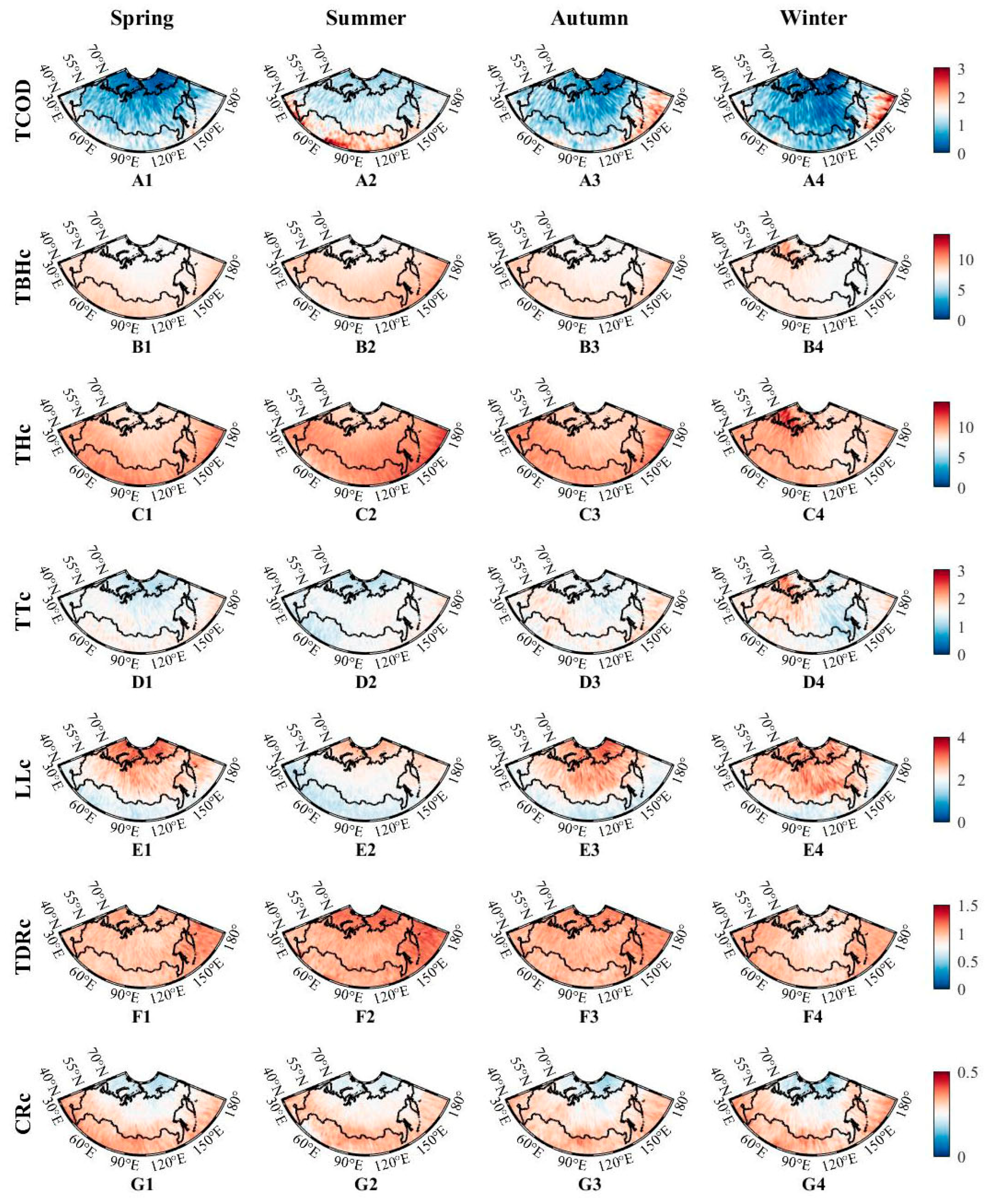
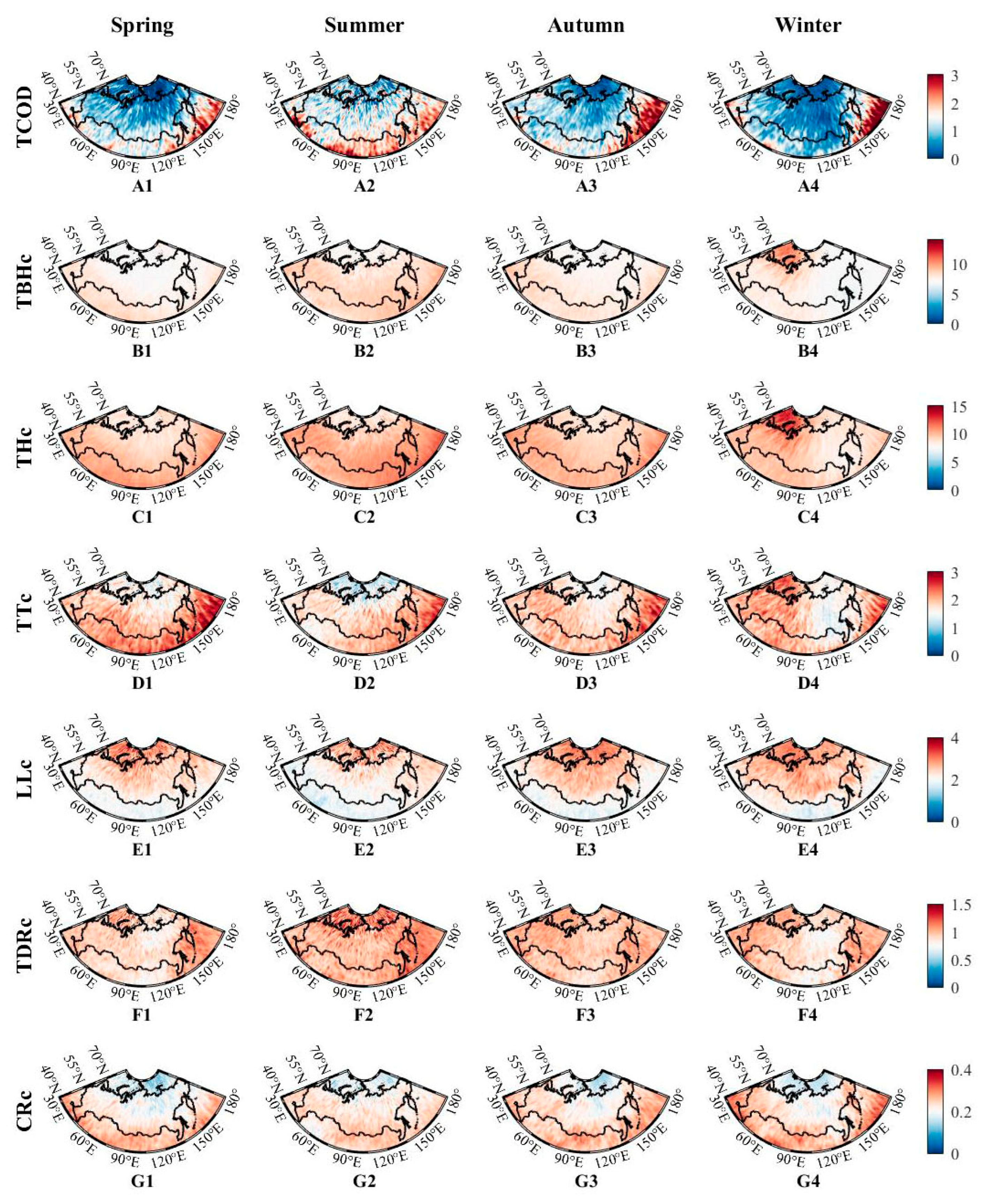
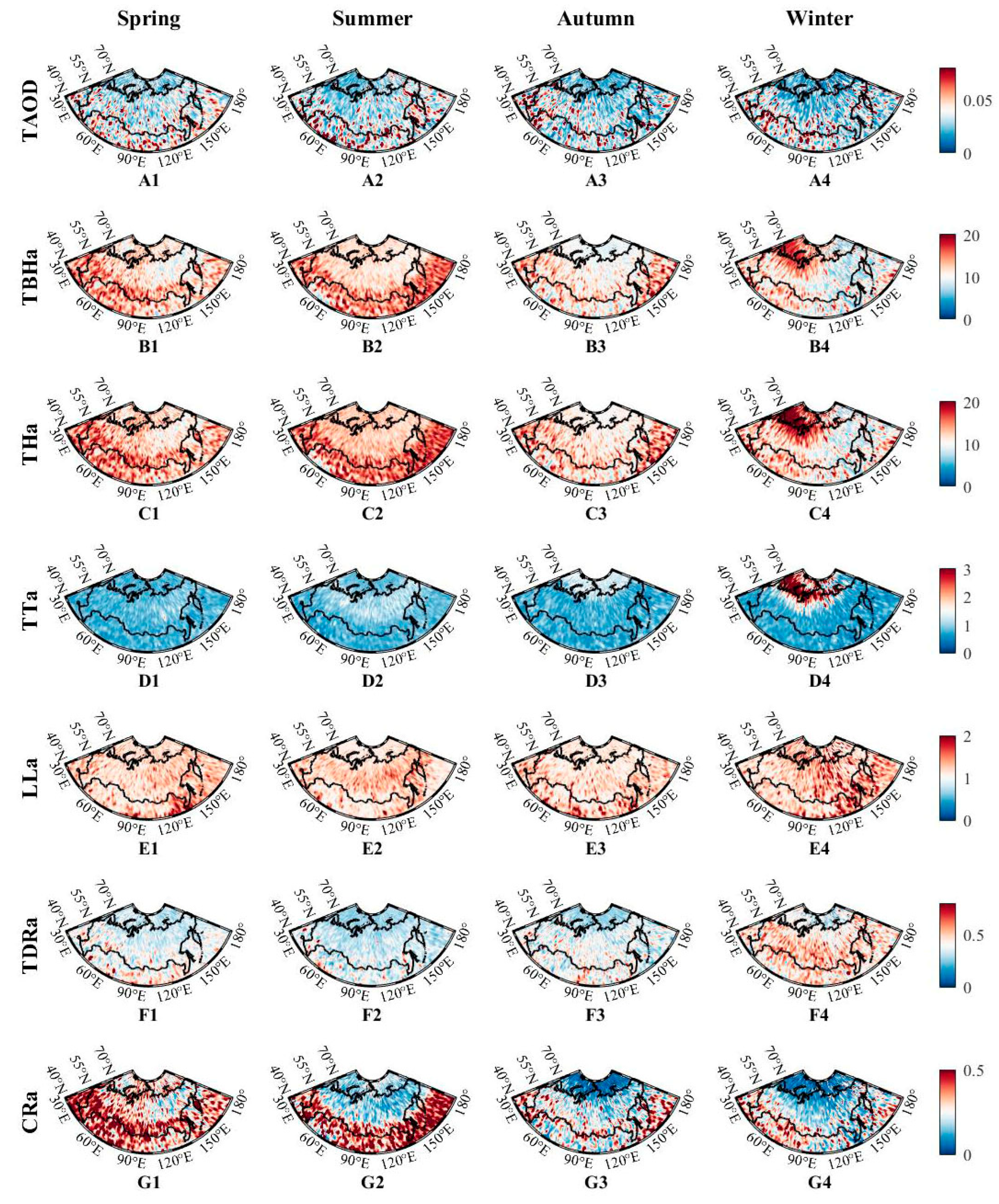

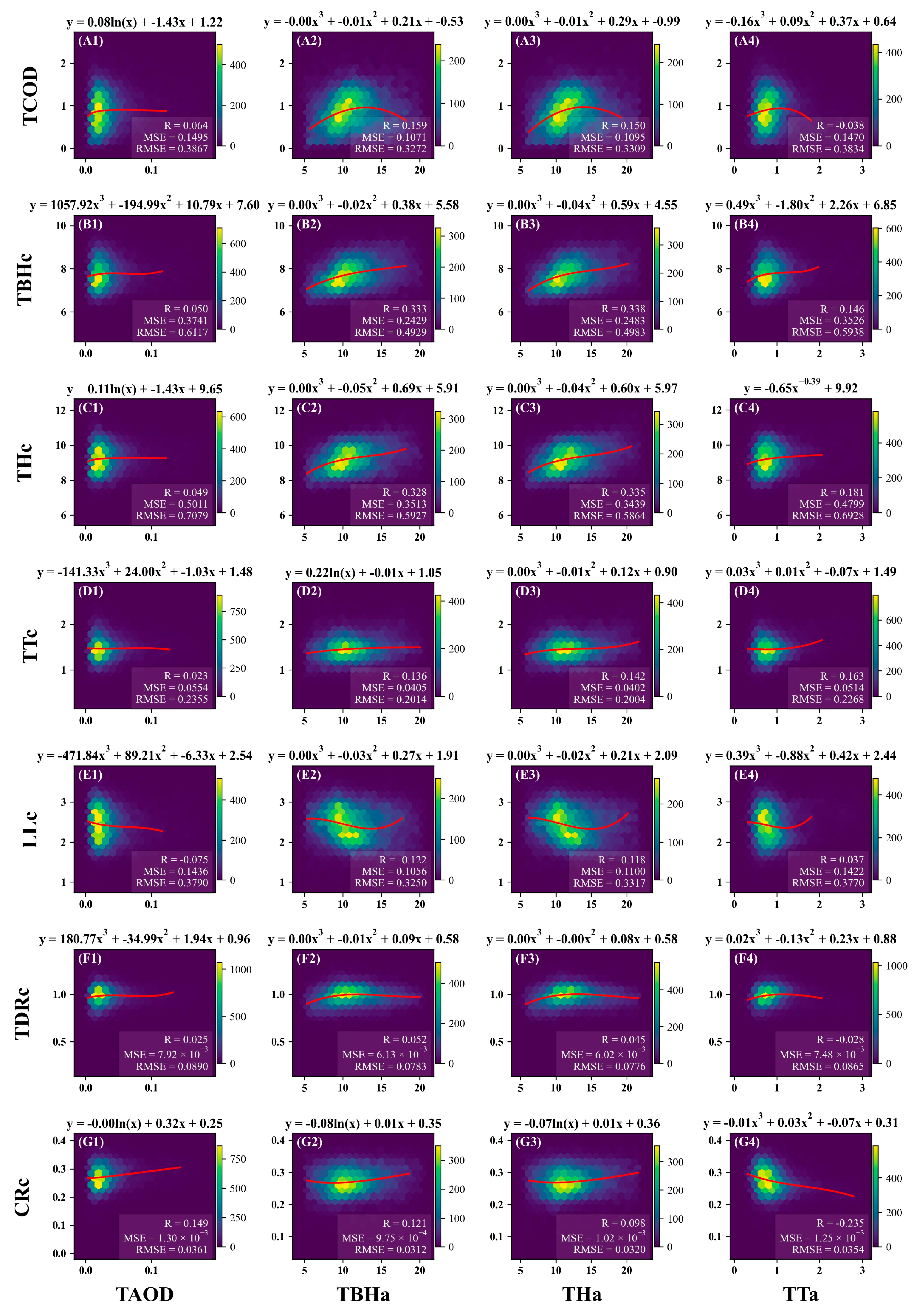
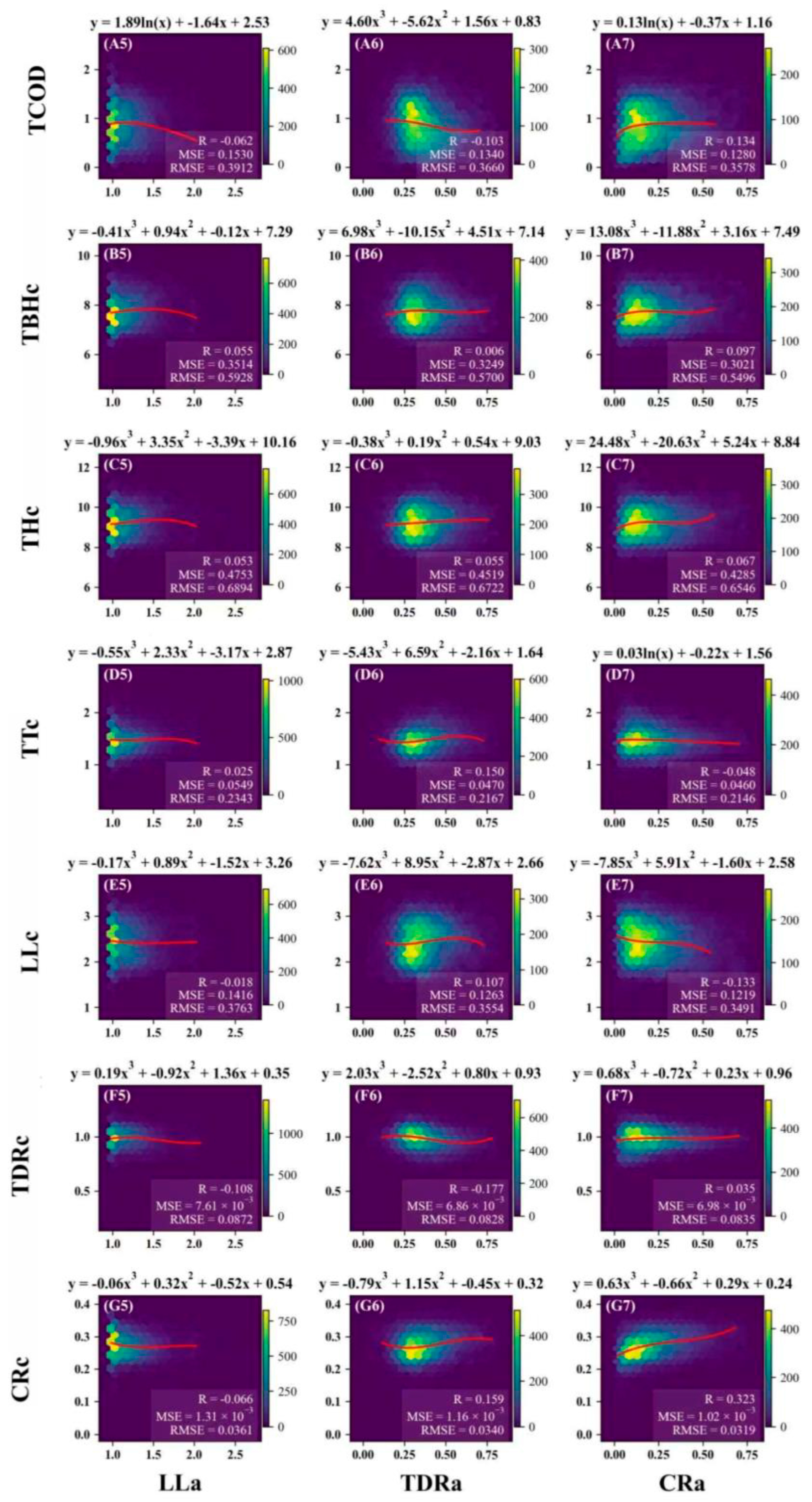

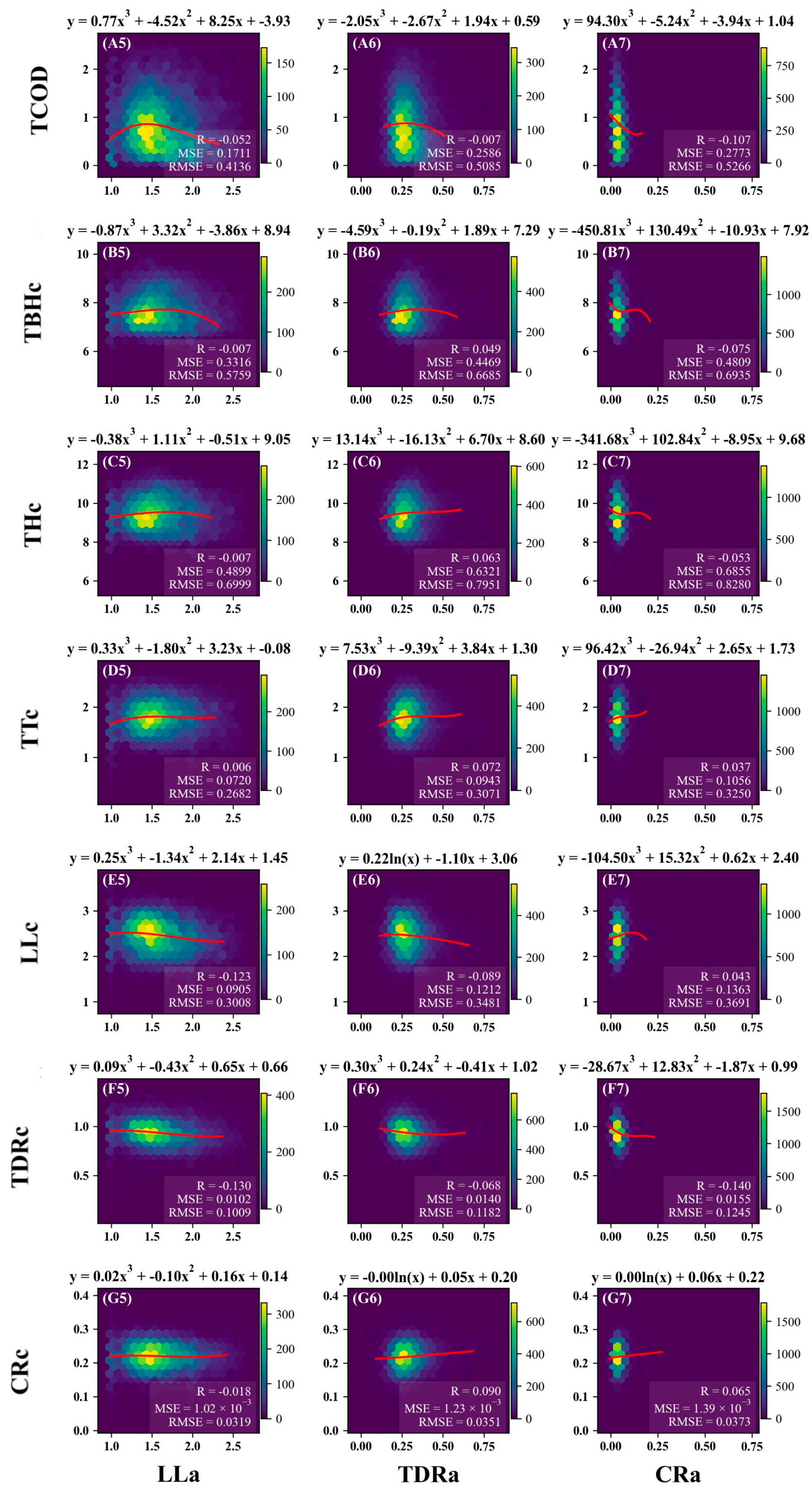
| Parameter | Abbreviation |
|---|---|
| Top Cloud Optical Depth | TCOD |
| op Aerosol Optical Depth | TAOD |
| Color Ratio (Cloud/Aerosol) | CRc/CRa |
| Top Depolarization Ratio (Cloud/Aerosol) | TDRc/TDRa |
| Top Base Height (Cloud/Aerosol) | TBHc/TBHa |
| Top Height (Cloud/Aerosol) | THc/THa |
| Top Thickness (Cloud/Aerosol) | TTc/TTa |
| Layer Level (Cloud/Aerosol) | LLc/LLa |
| Season | Time Period | TCOD | TBHc | THc | TTc | LLc | TDRc | CRc |
|---|---|---|---|---|---|---|---|---|
| Area A | ||||||||
| Spring | Day | 0–1 | 5–10 | 10–15 | 1–2 | 0–2 | 1–1.5 | 0.25 |
| Summer | Day | 1–2 | 8–10 | 10–15 | 1–2 | 0–2 | 1–1.5 | 0.25 |
| Autumn | Day | 0–1 | 5–10 | 10–15 | 1–2 | 0–2 | 1–1.5 | 0.25 |
| Winter | Day | 0–1 | 5–10 | 10–15 | 2–3 | 2–3 | 1–1.5 | 0.25–05 |
| Area B | ||||||||
| Spring | Day | 0–1 | 5–7 | 6–8 | 1.0–1.5 | 2.0–2.5 | 0.6–0.8 | 0.20–0.30 |
| Summer | Day | 1–2 | 7–9 | 8–9 | 1.0–1.5 | 2.0–2.5 | 1.0–1.2 | 0.25–0.35 |
| Autumn | Day | 0–1 | 7–9 | 8–9 | 1.5–2.0 | 3.0–3.5 | 1.0–1.2 | 0.30–0.35 |
| Winter | Day | 0–1 | 4–6 | 6–7 | 2.0–2.5 | 2.0–2.5 | 0.6–0.8 | 0.25–0.30 |
| Area C | ||||||||
| Spring | Day | 0.5–1.0 | 6–8 | 7–9 | 1.5–2.0 | 2.5–3.0 | 0.8–1.0 | 0.25–0.35 |
| Summer | Day | 1.0–2.0 | 8–9 | 10–12 | 1.5–2.0 | 1.5–2.0 | 1.0–1.2 | 0.15–0.25 |
| Autumn | Day | 0.5–1.0 | 7–9 | 7–9 | 1.5–2.0 | 3.0–3.5 | 1.0–1.2 | 0.35–0.40 |
| Winter | Day | 0.5–1.0 | 7–9 | 7–9 | 1.5–2.0 | 3.0–3.5 | 0.7–1.0 | 0.35–0.40 |
| Area D | ||||||||
| Spring | Day | 0.5–1.0 | 5–7 | 7–9 | 0.5–1.0 | 2.0–3.0 | 0.7–1.0 | 0.10–0.20 |
| Summer | Day | 1.5–2.0 | 7–9 | 9–10 | 1.5–2.0 | 1.5–2.0 | 1.0–1.2 | 0.20–0.30 |
| Autumn | Day | 0.5–1.0 | 5–7 | 7–9 | 1.5–2.0 | 3.0–3.5 | 0.7–1.0 | 0.10–0.20 |
| Winter | Day | 0.0–1.0 | 5–6 | 6–7 | 1.0–1.5 | 2.5–3.0 | 0.5–1.0 | 0.20–0.30 |
| Season | Time Period | TAOD | TBHa | THa | TTa | LLa | TDRa | CRa |
|---|---|---|---|---|---|---|---|---|
| Area A | ||||||||
| Spring | Day | 0.02–0.03 | 8–12 | 10–14 | 0.5–1.0 | 0.6–1.0 | 0.2–0.3 | 0.25–0.50 |
| Summer | Day | 0.03–0.04 | 12–16 | 14–18 | 0.5–1.0 | 1.2–1.6 | 0.2–0.3 | 0.15–0.40 |
| Autumn | Day | 0.03–0.04 | 10–14 | 12–16 | 0.8–1.2 | 1.0–1.4 | 0.3–0.4 | 0.10–0.20 |
| Winter | Day | 0.02–0.03 | 4–8 | 8–12 | 1.5–2.0 | 0.4–0.8 | 0.4–0.5 | 0.10–0.20 |
| Area B | ||||||||
| Spring | Day | 0.03–0.04 | 10–14 | 12–16 | 1.0–1.5 | 0.8–1.2 | 0.2–0.3 | 0.20–0.30 |
| Summer | Day | 0.04–0.05 | 10–12 | 12–16 | 1.0–1.5 | 1.4–1.8 | 0.1–0.3 | 0.20–0.30 |
| Autumn | Day | 0.03–0.04 | 8–10 | 10–12 | 1.0–1.8 | 0.6–1.0 | 0.2–0.3 | 0.15–0.25 |
| Winter | Day | 0.02–0.03 | 10–14 | 12–16 | 2.0–2.5 | 1.2–1.6 | 0.5–0.7 | 0.15–0.25 |
| Area C | ||||||||
| Spring | Day | 0.02–0.03 | 12–16 | 14–16 | 0.5–1.0 | 0.8–1.2 | 0.2–0.3 | 0.25–0.35 |
| Summer | Day | 0.02–0.03 | 12–16 | 14–18 | 1.0–1.5 | 1.0–1.4 | 0.2–0.3 | 0.15–0.25 |
| Autumn | Day | 0.02–0.03 | 10–12 | 12–14 | 0.5–1.0 | 0.8–1.2 | 0.3–0.4 | 0.20–0.30 |
| Winter | Day | 0.01–0.02 | 8–10 | 10–12 | 1.0–3.0 | 1.4–1.8 | 0.4–0.6 | 0.20–0.30 |
| Area D | ||||||||
| Spring | Day | 0.02–0.03 | 10–14 | 12–16 | 0.5–1.0 | 1.0–1.4 | 0.3–0.4 | 0.25–0.40 |
| Summer | Day | 0.02–0.03 | 12–16 | 14–16 | 1.5–2.0 | 1.0–1.4 | 0.2–0.3 | 0.25–0.35 |
| Autumn | Day | 0.01–0.02 | 10–12 | 10–14 | 0.5–1.0 | 1.0–1.2 | 0.3–0.4 | 0.15–0.25 |
| Winter | Day | 0.01–0.02 | 6–10 | 8–12 | 0.5–1.0 | 1.6–2.0 | 0.4–0.6 | 0.15–0.25 |
| Cloud–Aerosol Parameter Pair | Time | R | MSE | RMSE | Key Physical Meaning |
|---|---|---|---|---|---|
| THc–THa | Daytime | 0.335 | 0.3439 | 0.5864 | Stable stratification enhances aerosol–ice cloud interactions in 7–12 km range |
| Nighttime | 0.527 | 0.4330 | 0.6581 | ||
| TDRc–TAODa | Daytime | 0.025 | 7.92 × 10−3 | 0.089 | Radiative effects of aerosols regulate ice crystal orientation |
| Nighttime | 0.028 | 0.0156 | 0.1248 | ||
| TDRc–TDRa | Daytime | −0.177 | 6.86 × 10−3 | 0.0828 | Aerosol morphology influences cloud particle nonsphericity with threshold dependence |
| Nighttime | −0.068 | 0.014 | 0.1182 | ||
| TDRc–TTa | Daytime | −0.028 | 7.48 × 10−3 | 0.0865 | Aerosol layer thickness modulates intra-cloud temperature gradients and ice growth |
| Nighttime | 0.154 | 0.0108 | 0.1039 | ||
| TBHc–TBHa | Daytime | 0.333 | 0.2429 | 0.4929 | Lower-altitude coupling weakens with height due to changing dynamical conditions |
| Nighttime | 0.587 | 0.2702 | 0.5198 | ||
| TCOD–TAOD | Daytime | 0.064 | 0.1495 | 0.3867 | Thin aerosol and cloud layers dominate; thick aerosol layers are rare in high latitudes |
| Nighttime | 0.084 | 0.2796 | 0.5288 | ||
| TTc–TTa | Daytime | 0.163 | 0.0514 | 0.2268 | Both layers dominated by thin structures; aerosol influence shows “saturation effect” |
| Nighttime | 0.081 | 0.0774 | 0.2782 |
Disclaimer/Publisher’s Note: The statements, opinions and data contained in all publications are solely those of the individual author(s) and contributor(s) and not of MDPI and/or the editor(s). MDPI and/or the editor(s) disclaim responsibility for any injury to people or property resulting from any ideas, methods, instructions or products referred to in the content. |
© 2025 by the authors. Licensee MDPI, Basel, Switzerland. This article is an open access article distributed under the terms and conditions of the Creative Commons Attribution (CC BY) license (https://creativecommons.org/licenses/by/4.0/).
Share and Cite
Zhang, M.; Su, Z.; Luo, Z.; Zhang, Y.; Liu, Z.; Chen, T.; Liu, Y.; Han, G. Seasonal Variations and Correlations of Optical and Physical Properties of Upper Cloud-Aerosol Layers in Russia Based on Lidar Remote Sensing. Atmosphere 2025, 16, 1015. https://doi.org/10.3390/atmos16091015
Zhang M, Su Z, Luo Z, Zhang Y, Liu Z, Chen T, Liu Y, Han G. Seasonal Variations and Correlations of Optical and Physical Properties of Upper Cloud-Aerosol Layers in Russia Based on Lidar Remote Sensing. Atmosphere. 2025; 16(9):1015. https://doi.org/10.3390/atmos16091015
Chicago/Turabian StyleZhang, Miao, Zijun Su, Zixin Luo, Yating Zhang, Zhibiao Liu, Tianhang Chen, Yachen Liu, and Ge Han. 2025. "Seasonal Variations and Correlations of Optical and Physical Properties of Upper Cloud-Aerosol Layers in Russia Based on Lidar Remote Sensing" Atmosphere 16, no. 9: 1015. https://doi.org/10.3390/atmos16091015
APA StyleZhang, M., Su, Z., Luo, Z., Zhang, Y., Liu, Z., Chen, T., Liu, Y., & Han, G. (2025). Seasonal Variations and Correlations of Optical and Physical Properties of Upper Cloud-Aerosol Layers in Russia Based on Lidar Remote Sensing. Atmosphere, 16(9), 1015. https://doi.org/10.3390/atmos16091015







